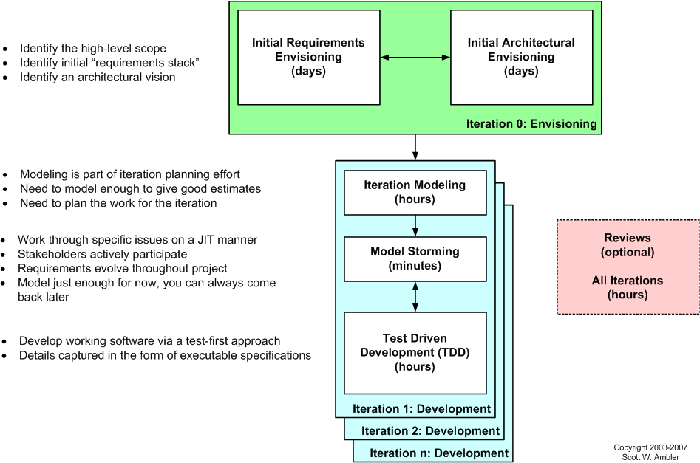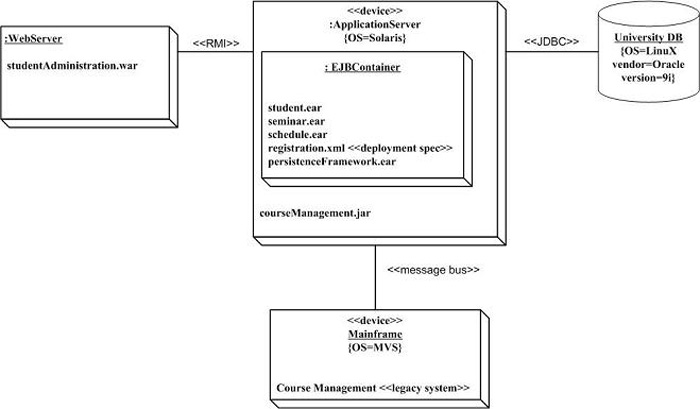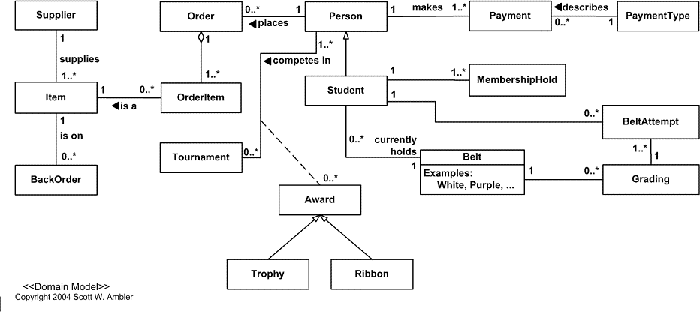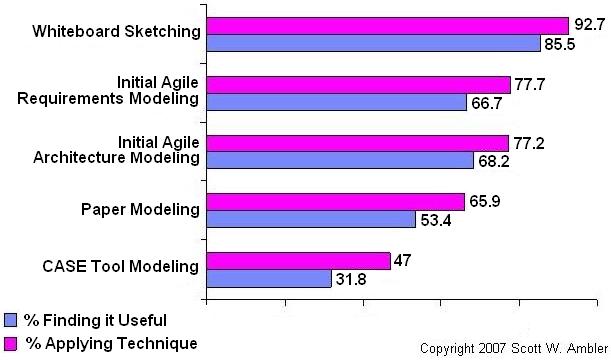| UML软件工程组织 | |||
| |
|||
|
|||
Initial High-Level Architectural Envisioning
| A common agile practice is to perform some high-level architectural modeling early in the project to help foster agreement regarding your technical strategy within the team and with critical stakeholders. The goal at this point is to identify an architectural strategy, not write mounds of documentation, enabling you to do this swiftly. You will work through the design details later during development cycles in model storming sessions and via TDD. This article addresses several critical questions:
1. When Should You Do Initial Agile Architecture Modeling?Agile Model Driven Development (AMDD), see Figure 1, explicitly includes an initial architectural modeling effort during Iteration 0 of an agile project (what some processes might call the Warm-UP, Inception, or Initiation phase). Initial architecture modeling is particularly important for scaling agile software development techniques to large, complex, or globally distributed development (GDD) efforts. Figure 1. The AMDD lifecycle: Project Viewpoint.
2. Why Should You Do Some Initial Agile Architecture Modeling?Some people will tell you that you don抰 need to do any initial architecture modeling at all. However, my experience is that doing some initial architectural modeling in an agile manner offers several benefits:
3. What Should You Model Initially?Early in the project you need to have at least a general idea of how you're going to build the system. Is it a mainframe COBOL application? A .Net application? J2EE? Something else? To do this the developers on the project will get together in a room, often around a whiteboard, discuss and then sketch out a potential architecture for the system. This modeling work is based on, and performed in parallel to, your initial high-level requirements modeling efforts. Your architecture will evolve over time so it does not need to be very detailed yet (it just needs to be good enough for now), and very little documentation (if any) needs to be written. When I'm doing initial architectural modeling I'll typically focus on high-level free-form diagrams which overview how we think we'll build the system. I will typically focus on: 3.1 Technology DiagramsOften some form of technology stack diagram (Figure 2) or deployment diagram will do (Figure 3). These diagrams are useful because they depict the major software and hardware components and how they interact at a high level. This includes legacy assets, including legacy databases and legacy systems, which may need to be analyzed in greater detail later in the project. Right now your goal should be to identify these assets and perhaps discuss their viability as sources of functionality and/or data for your system. Figure 2. A technology stack diagram.
Figure 3. A UML deployment diagram. You will also be identifying technical constraints at this point in time. For example, although you would love to work with the latest version of DB2, unfortunately your corporate database standard is Oracle (as you see in Figure 2) and you're therefore constrained in that architectural choice. 3.2 User Interface Flow ModelsAnother common diagram to create is a user interface (UI) navigation or UI-flow diagram, see Figure 4, to explore how you will architect the UI of your system by exploring the flow between major UI elements, including both screens/pages and reports. This is critical to your system's success because the user interface is the system to your stakeholders. Not the technology. Not the data. Not really cool frameworks that you're working with. If you do not architect the user interface effectively you run the risk that you will build a system that your stakeholders aren't interested in working with. Figure 4. A UI flow diagram. 3.3 Domain ModelsPart of your initial architectural modeling efforts, particularly for a business application, will likely include the development of high-level domain model as you see in Figure 5. This model should be very slim, capturing the main business entities and the relationships between them. Some people consider this type of model to be an initial requirements model instead of an initial architecture model -- it doesn't really matter because as you see in Figure 1 both of these initial modeling efforts are performed in parallel anyway. Figure 5 depicts an example using UML data modeling notation (you can use any notation that you like when agile data modeling, I prefer UML). The initial domain model will be used to help guide both the physical data model as well as the class design, potentially captured via a UML class diagram. I will often create this type of diagram using a whiteboard initially and then later I might transfer it into a drawing tool if the effort of doing so provides sufficient value. Figure 5. Initial domain model. 3.4 Change CasesFinally, another common architectural model that I sometimes consider capturing are change cases which are potential architecture-level requirements which your system may need to support. Figure 6 provides examples of two change cases, the describing a potential a technology change and the second a potential business change. Change cases allow you to test the long-term viability of your architecture without requiring you to overbuild your system because you can think through the impact of likely changes to ensure yourself that your system will still work. Figure 6. Two change cases.
4. What Modeling Tools Should You Use?Agile modelers will use the simplest tool which will get the job done. As you can see in Figure 2 and Figure 4 I抳e found whiteboard diagrams typically suffice for initial architecture models. Your goal is to think through the critical technical issues at this point in the lifecycle, not create pretty diagrams. There's nothing wrong with using more sophisticated drawing tools, as you can see in Figure 3 and Figure 5, just ensure that the investment you're putting into the effort is worth it. It all depends on the situation that you're working in. Furthermore, paper-based tools are also quite common. For example I would be tempted to initially capture the change cases of Figure 6 on index cards and only capture them using a more sophisticated tool if appropriate. 5. How Much Initial Architectural Modeling Should You Do?Let抯 consider several common situations that you project team might find itself in, and then reflect upon how much architectural modeling would be appropriate in that situation. These scenarios are:
My experience is that you will gain some value from initial architectural modeling when your team is dispersed amongst several sites, or if it抯 large, or if you have several subteams because it will help you to organize your efforts. It helps you to grow a common vision between the subteams but more importantly you can identify separate components/subsystems, and the initial interfaces to those components, which can then be assigned to the subteams. These interfaces will evolve over time, so you抣l need to collaborate with one another throughout the project, but once again some initial architecture modeling will provide significant benefit. 6. Why Do You Need to Do Less Initial Modeling Than Traditionalists Think?Traditional modelers assume that it is desirable to model the problem and solution domain in detail at the beginning of a project. I refer to this as "big modeling up front (BMUF)", something which encompasses "big requirements up front (BRUF)" where you create a detailed requirements specification early in the lifecycle and "big design up front (BDUF)" where you create a detailed requirements specification early in the lifecycle. These practices make sense when you're a modeling specialist, and sure enough traditional modelers always have seem to have good reasons for why BMUF is desirable. Table 1 summarizes the common arguments for doing detailed architecture models early in a project and argues why they're wrong. Table 1. The Arguments, and Counter Arguments Against, Architectural BMUF.
7. Are People Actually Doing This?Yes! In my Agile Adoption Rate survey in March 2007 one of the questions that I asked was how effective initial agile architectural modeling was on agile teams. The results is summarized in the histogram of Figure 7. As you can see, Agilists do in fact model in practice. 77.2 percent of respondents who said that their organizations were doing Agile indicated that those teams were also doing initial high-level agile architecture modeling, and that 88.3% of those teams found the effort worthwhile (they gave it a rating of 3 or more out of 5). Figure 7. Adoption Rates of Modeling on Agile Teams. 8. Parting ThoughtsYou should strive to do just enough modeling for the situation at hand and no more. The implication is that there is no one correct answer for how much modeling each project team will do, that instead it will vary from team to team. My philosophy is that repeatable results, in this case having a shared architectural vision within the team, are far more important than following a repeatable process that ensures that each team does the same amount of modeling each time. In later iterations both your initial requirements and your initial architect models will need to evolve as you learn more, but for now the goal is to get something that is just barely good enough so that your team can get going. In subsequent releases you may decide to shorten iteration 0 to several days, several hours, or even remove it completely as your situation dictates. The secret is to keep things simple. You don抰 need to model a lot of detail, you simply need to model enough. If you抮e writing use cases this may mean that point-form notes are good enough. If you抮e domain modeling a whiteboard sketch or collection of CRC cards is likely good enough. For your architecture a whiteboard sketch overviewing how the system will be built end-to-end is good enough. I cannot say this enough: your goal is to build a shared understanding, it isn抰 to write detailed documentation. A critical success factor is to use inclusive modeling techniques which enable active stakeholder participation. Many traditional developers will struggle with an agile approach to initial modeling because for years they抳e been told they need to define comprehensive models early in a project. Agile software development isn抰 serial, it抯 iterative and incremental (evolutionary). With an evolutionary approach detailed modeling is done just in time (JIT) during development iterations in model storming sessions. 9. Recommended Resources
|
组织简介 | 联系我们 | Copyright 2002 ® UML软件工程组织 京ICP备10020922号 京公海网安备110108001071号 |



